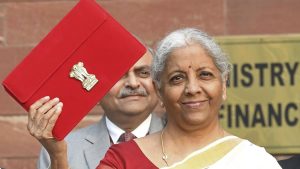
The Union Budget 2025 aims to give a significant boost to India’s air cargo, warehousing, and MSME sectors, recognising their pivotal role in driving export growth and economic prosperity. By focusing on enhancing air cargo infrastructure, improving warehousing facilities, and providing targeted support to MSMEs, the government seeks to streamline supply chains, reduce logistics costs, and increase the country’s competitiveness in the global market.
To achieve the goal of ‘Viksit Bharat’ 2047, Union Finance Minister, Nirmala Sitharaman presented the Union Budget 2025-2026 focusing on the Micro, Small and Medium Enterprises (MSMEs) to be the second engine of growth for ‘Viksit Bharat.’ The budget also focused on boosting exports out of India especially of high-value perishables and agri produce. Export Promotion Mission to be set up jointly by the ministries of Commerce, MSME and Finance. It will facilitate easy access to export credit, cross-border factory support, support to MSMEs to tackle non-direct measures in overseas markets. Digital public infrastructure for international trade will be set up as a unified platform for trade documentation and financing solutions. This will complement the unified logistics interface platform (ULIP). Support will be provided to develop domestic manufacturing capacities for economies’ integration with global supply chains. PM Gati Shakti data will be made accessible to the private sector, and the development of the top 50 tourist destinations will be carried out in partnership with state governments. Cargo screening and customs clearance processes will be made more user-friendly to improve efficiency and ease for stakeholders. Sectors will be identified based on objective criteria. Presentation groups with participation of senior officers and industry representatives will be formed for selected products and supply chains. Through this, there will be huge opportunities related to industry 4.0, which needs high skills and talent. The national framework will be formulated as guidance to states for promoting global capability centres in emerging tier 2 cities. Our government will facilitate upgradation of infrastructure and warehousing for air cargo, including high value perishables and agri produce. The investment and turnover limits for classification of all MSMEs will be enhanced to 2.5 and 2 times respectively. This will give them the confidence to grow and generate employment for our youth. There will be a boost in technological upgradation for MSMEs.
C K Govil, President, ACAAI says, “The Union Budget 2025-26 has been designed with a strategic focus on balancing economic growth and fiscal responsibility, ensuring that development reaches various sectors while maintaining prudent financial discipline. Here’s a breakdown of its key aspects: Manufacturing and Industrial Development, Make in India’ Push: National Manufacturing Mission to promote domestic production. Support for MSMEs: Expanded credit guarantee schemes to help small businesses grow, Ease of Doing Business: Reduction in compliance burdens and faster approvals for industries.
Infrastructure and Urban Development
- Interest-Free Loans to States: ₹1.5 trillion allocated for state infrastructure projects, boosting regional development.
- Maritime Development Fund: Investments in port infrastructure to enhance trade efficiency.
- Urban Challenge Fund: Encouraging smart city projects and innovative urban planning.
Digital & Technological Advancement
- AI and Innovation Fund: Support for AI startups, research, and skill development.
- Expansion of Digital Public Infrastructure: Strengthening India’s digital economy, fintech, and cybersecurity measures.
- Fiscal Responsibility and Stability
- Targeted Fiscal Deficit Reduction: The government aims to bring down the fiscal deficit to 4.5% of GDP, ensuring financial stability.
- Sustainable Borrowing: Maintaining fiscal discipline while funding infrastructure and social programs.
- Rationalizing Subsidies: Efficient targeting of subsidies to avoid unnecessary fiscal burdens.
- Support for the Middle Class and Consumers
- Income Tax Reforms: Likely reductions or restructuring to boost disposable income and spending.
- Affordable Housing Benefits: Strengthened PMAY (Pradhan Mantri Awas Yojana) for housing accessibility.
- Consumer Spending Push: Incentives for sectors like real estate, automobiles, and FMCG to drive consumption.
- Capital Market and Investor Confidence
- Stock Market Growth: Positive response from investors post-budget announcement.
- Regulatory Stability: Measures to ensure smooth capital flows and encourage investment.
- Support for Startups & Entrepreneurship: Tax reliefs and funding access for new businesses.
Conclusion
This budget follows a balanced approach—it boosts economic momentum through investments in agriculture, manufacturing, and digital growth while ensuring that fiscal prudence is maintained. The combination of growth-oriented policies and responsible financial management aims to sustain India’s economic expansion while keeping inflation and deficits under control.”
Amit Maheshwari, CEO & Founder, Softlink Global says, “The Finance Bill 2025 makes some progress in streamlining customs processes and tax compliance for logistics, but it also increases the regulatory burden on freight forwarders. Faster dispute resolution and improved customs duty assessments will help reduce clearance delays, but enhanced powers for reassessments could lead to unexpected cost escalations. A key missed opportunity in this bill is the lack of incentives for AI and automation in logistics. While global markets are actively investing in AI-driven supply chain optimization, India’s logistics sector is left without structured tax benefits for AI-powered automation, paperless trade, and blockchain security solutions. If we want to position India as a global logistics leader, we need policies that encourage digital transformation and next-gen logistics technology. We hope to see these gaps addressed in future reforms.”
Satish Lakkaraju, CEO, Garudavega, NexGen Logistics says, “The Union Budget 2025 marks a significant milestone for India’s logistics and trade sector, with a strong emphasis on infrastructure development, digitalisation, and business-friendly reforms. Key highlights include the government’s ongoing focus on PM Gati Shakti, which promises to enhance multimodal connectivity, reduce transit times, and bring down logistics costs. The introduction of Bharat Trade Net (BTN), a unified digital platform for trade documentation and financing, is a game-changer, streamlining cross-border logistics and customs clearance processes. Additionally, the investment in modern air cargo warehousing facilities, particularly for high-value perishable goods, will significantly enhance trade efficiency. The rationalization of TDS and TCS and reductions in import duties on key logistics equipment will ease compliance burdens and make operations more cost-effective. Furthermore, the increase in personal income tax exemption to ₹12 lakh (₹12.75 lakh for salaried employees) is expected to boost consumer spending, indirectly benefiting logistics and e-commerce. This budget represents a decisive step toward India becoming a global supply chain leader. By focusing on infrastructure, digital transformation, and tax reforms, it will empower businesses, strengthen trade efficiency, and create a more resilient logistics framework. With continued collaboration between the government and the private sector, India is well on its way to becoming a logistics powerhouse, enhancing its economic resilience and global competitiveness.”
Vipin Vohra, Chairman, Continental Carriers says, “The Union Budget 2025-26 charts an ambitious course for growth while maintaining fiscal responsibility, with a strong focus on the logistics, air cargo, and supply chain sectors. Increased capital allocation for air cargo infrastructure in emerging industrial regions will strengthen connectivity with global trade routes, while upgraded warehousing and streamlined customs protocols will enhance cargo handling, particularly for high-value perishable goods. To equip the workforce for the future, five National Centres of Excellence will be established for skill development. Support for domestic manufacturing will be reinforced through facilitation groups comprising industry and government representatives. The introduction of BharatTradeNet (BTN) as a unified trade documentation and financing platform will complement the Unified Logistics Interface Platform (ULIP), enhancing digital integration.
• Additionally, a ₹25,000 crore Maritime Development Fund will promote competitiveness in global ocean trade.
• Recognizing the success of UDAN, the government will expand regional connectivity by linking 120 new destinations, operationalizing helipads and smaller airports, and targeting 4 crore passengers over the next decade.
Through strategic collaboration between the government and industry stakeholders, these initiatives will drive efficiency, modernization, and transformative growth in India’s logistics and air cargo sectors.
Amar More, Director & Co-Founder of Kale Logistics Solutions, said, “Modified UDAAN scheme is significant as it continues to connect several Indian cities to major urban clusters and the world. Bihar being a large state, developing Greenfield and Brownfield airports will promote growth of the region and make way for cargo movement of perishables from the state to the urban hubs and make way for exports. Upgradation of the air cargo industry for perishables and making cargo screening user-friendly will make air cargo movement a cake walk for all. Overall, this budget is streamlining the growth prospects set for a Viksit Bharat.”
Amit Bhargava, Partner and National Head, Mining & Metals, KPMG in India, said “Union Budget 2025 has recognized and empowered the aspirations of the metals and mining sector to further strengthen its global positioning, in terms of scale of production, greener product offerings and increased innovation.
The budget supports specifically in realizing mining potential, availability of digital capabilities, increasing value chain competitiveness, enabling energy transition and decarbonization, encouraging critical minerals related circularity and logistics efficiency.”
Some of the key takeaways are:
• Minor minerals mining and critical minerals recovery from tailings is a step to realize the potential of mining and availability of critical minerals (including exemption/ reduction of BCD on key critical minerals)
• Empowering MSMEs to enhance exports, access to technology and funding would be a step for improving the competitiveness of sector’s downstream value chain
• Clean technology focus that helps establishing domestic solar/ EV related manufacturing would be critical in further expediting the energy transition of the sector
• Centre of Excellence for AI and emphasis on Industry 4.0 would be instrumental in ensuring availability of key digital capabilities, so critically required by the sector
• India post infrastructure to be leveraged in bringing in greater logistics efficiencies
Gregory Goba Ble, Head of UPS India and Director of MOVIN Express, says, “As we reflect on the Union Budget 2025, I am encouraged by the government’s robust commitment to empowering our Micro, Small, and Medium Enterprises (MSMEs), which are vital to India’s economic growth and global manufacturing ambitions. The remarkable transformation of India Post into a major public logistics organisation stands as a testament to this commitment. This shift, coupled with robust contributions from the private sector, will effectively address the diverse business needs of Vishwakarmas, MSMEs, women entrepreneurs, and self-help groups across the nation. The budget’s enhancements in credit guarantees and increased investment limits for MSMEs represent a lifeline for small and medium enterprises striving to scale up and create jobs. With over 5.7 crore MSMEs at the heart of our economy, these initiatives will unleash their potential, driving innovation and fostering a vibrant entrepreneurial ecosystem. The government has consistently focused on supporting MSMEs, and this budget has not disappointed. Furthermore, the emphasis on technological upgrades and the introduction of customized credit cards for micro-enterprises are game-changing strategies that will elevate efficiency and competitiveness. By empowering these businesses with the necessary tools and resources, we can anticipate a wave of entrepreneurial spirit that will invigorate our economy. The budget’s focus on reducing logistics costs, enhancing skill development, and promoting green logistics through advanced electric vehicle infrastructure is not merely a response to current challenges but a bold step towards sustainability and innovation. These measures will not only fortify India’s logistics capabilities but also position our nation as a strategic hub for global trade, enabling us to compete fiercely on the international stage. In essence, the Union Budget 2025 lays a formidable foundation for a resilient and dynamic logistics and MSME ecosystem, championing growth, inclusivity, and sustainability. The collaborative efforts between the public and private sectors will be instrumental in realizing these ambitious goals, ensuring a prosperous future for all.”
Ketan Kulkarni, Managing Director, Gati Express and Supply Chain Limited (Allcargo Gati Ltd.) says, “We welcome the government’s announcement of providing PM Gati Shakti data accessible to the private players, thus opening doors for improved collaboration and efficiency in infrastructure projects. This is poised to accelerate infrastructure growth across the country, streamlining the movement of goods and strengthening logistics efficiency. Besides this, the government’s decision to establish an Export Promotion Mission for facilitating easier access to export credits, providing cross-border factoring support, and assisting MSMEs in overcoming non-tariff barriers is a highly commendable step, as it will empower MSMEs to expand their international footprint. Additionally, the budgetary announcement of providing easy-term loans of up to ₹20 crore is going to provide a significant financial boost to MSMEs, enabling them to scale operations and enhance competitiveness. Furthermore, we are also thrilled by the announcements aimed at fostering rural prosperity, enhancing resilience, and alleviating the tax burden on the middle class. These measures will not only stimulate consumption but also serve as key drivers of long-term economic growth”.
Swarup Bose, Founder & CEO, Celcius Logistics, says,“The government’s focus on enhancing post-harvest infrastructure, including warehousing, is a significant step forward for the agriculture sector. Startups in cold chain technology and third-party logistics can play a pivotal role in improving storage solutions, ensuring that high-value perishable produce is preserved and efficiently transported, ultimately benefiting farmers and consumers alike.”
Jaideep Mirchandani, Group Chairman, Sky One, says, “The 2025 Budget announcements clearly outline the Government vision to invest in strengthening India’s aviation infrastructure and improving regional connectivity. In particular, the planned renovation of warehousing for air cargo in India, specifically for high-value horticulture fresh fruits, is an important contribution to achieving India’s logistics centric economy goal. The Streamlining of customs as well as cargo screening processes will certainly help to further increase effectiveness and minimize waiting periods and will positively impact businesses and end-users. With 120 target locations and an anticipated 4 crore passengers in his decade’s time, the amended UDAN scheme alongside new regional configurations, enhances the connectivity of the country beyond metros and will bring in a new wave of travel and connectivity. The new supporting helipads and new airports in the hilly and northeastern districts are sure to stimulate the economy of these unserved areas through trade, tourism and accessibility. The initiation of new greenfield airports in Bihar and the expansion of Patna’s airport indicates a much needed comprehensive strategy for the development of aviation in the country. The Economic Survey also brings forth the high level of activity that the aviation sector is experiencing as the Ministry of Civil Aviation makes use of 69% of the earmarked capex for FY25 to the regions after the Ports and Shipping. Most importantly, airport builders seem set to exceed the ₹91,000 crore expenditure goal from FY20-FY25. Evidence of this expansion of the Indian footprint on air travel is in the fact that there are 619 operational routes with 88 airports under the successful UDAN scheme. Another positive sentiment is that the cargo segment is also growing strongly, with the handling capacity expected to grow from 7.4 million metric tonnes for FY22 to 8 million MT for FY24. This is part of the growing requirement for air freight logistics and reaffirms India’s capability ambitions as a global logistics center. While such plans and programs provide a boost to aviation sector growth, I also would like the Government’s attention in the Aviation skill development and Sustainable Aviation Fuel (SAF) to support India’s ambitious plans in global aviation leadership.”
Gayomard Driver, Executive Director & Group Chief Financial Officer, Jeena & Company, says, “The Union Budget 2025-26 reaffirms the government’s commitment to infrastructure development, taking it to new heights. We welcome this focus, particularly on strengthening logistics through enhanced infrastructure, digital transformation, and supportive policies, which will be a game changer for India’s supply chain ecosystem. The introduction of the Bharat Trade Net Platform for seamless trade documentation and financing, along with the ₹25,000 crore Maritime Development Fund, are strategic moves that will drive efficiency, and boost global competitiveness. Maritime Development Fund will not only enhance India’s logistics and trade capabilities but also provide employment opportunities across diverse skill levels—from blue-collar workers to high-tech professionals—ensuring inclusive growth in the maritime economy. Additionally, the push for modernizing air cargo, investing in geospatial infrastructure, fostering AI-driven innovation, and promoting public-private partnerships will further enhance connectivity and operational agility. These transformative initiatives position India on the path to becoming a global logistics powerhouse.”
Subramaniam Thiruppathi, Director- India and Sub-Continent, Zebra Technologies, says, “The Bharat Trade Net (BTN) platform revolutionizes India’s logistics sector by integrating with the Unified Logistics Platform (ULP) for real-time shipment tracking. Along with this, leveraging RFID, barcode scanners, and mobile computing enhances digital traceability and inventory management. BTN also streamlines customs procedures through paperless trade and automation, aligning with global standards. Zebra’s track-and-trace solutions integrate seamlessly with digital documentation, expediting clearance and improving efficiency. By adhering to WCO SAFE and UN/CEFACT standards, BTN ensures compliance, enhances supply chain transparency, and expands market opportunities. This initiative strengthens India’s global trade position, driving efficiency and competitiveness in logistics and manufacturing.”
KK Agarwal, Chairman & Managing Director, CJ Darcl Logistics, says, “We commend the budget for its focus on strengthening the shipping sector with ₹25,000 crore Maritime Development Fund along with the Tonnage Tax Scheme’s expansion to inland vessels that will together enhance port connectivity and streamline maritime operations. The government’s plan to set up a digital public infrastructure ‘BharatTradeNet’ (BTN) for ease of documentation in international trade, domestic manufacturing capacities to integrate the Indian economy with the global supply chain and help private sector with data and maps from PM Gati Shakti’s insights are admirable initiatives that will boost domestic as well as international trade. Furthermore, the budget’s focus on improving air cargo infrastructure and the launch of ‘Udaan 2.0’, connecting 120 new destinations is a welcoming move for the logistics sector. Overall, this budget is a strong step towards the broader vision of ‘Viksit Bharat’ by 2047. We, at CJ Darcl, are looking forward to the opportunities these projects present and are dedicated to support the government in developing a robust, sustainable, and globally competitive logistics ecosystem.”
Sunil Kohli, Managing Director, Rahat Cargo, says “It’s pleasing to note that the Budget-25 is aimed to focus on accelerating growth and enhance spending. The Finance Minister’s proposal to induct a comprehensive programme for raising vegetables, fruits production, and providing remunerative prices is a welcome step. Hopefully due consideration by the FM will also be made towards encouraging the export of vegetables by incentivizing the process. The doubling of turnover limits for MSME classification would help boost this sector. The Budget aims to initiate transformative reforms across six vital domains namely Taxation, Power sector, Urban development, Mining & Financial Sector. Expectedly during the next five years, these will augment our growth potential and global competitiveness. By amending income tax structure, simplifying taxation and easing compliance, the government reinforces its commitment to a taxpayer-friendly system. This reform not only benefits salaried individuals but also supports businesses and investment, driving overall prosperity.”
Amit Tandon, CEO & Managing Director of Asia Shipping India, said, “The Union Budget for 2025-26 marks a significant step forward in enhancing and strengthening India’s shipping and logistics infrastructure. The government’s focus on upgrading air cargo infrastructure, particularly for high-value perishable horticulture produce, will undoubtedly boost the efficiency and competitiveness of India’s logistics sector. Streamlining cargo screening and customs protocols, coupled with the extension of BCD exemptions for shipbuilding materials, will greatly reduce operational complexities and improve the ease of doing business. The proposal to launch a modified UDAN scheme to enhance regional connectivity to 120 new domestic destinations is a forward-thinking move, enabling faster, more efficient transportation across India. The focus on supporting helipads and smaller airports in the North East and hilly regions will foster greater regional integration, making logistics more accessible and cost-effective. Additionally, the establishment of the Maritime Development Fund with a corpus of ₹25,000 crore will provide long-term financing to support the growth of the maritime industry, making it more competitive on the global stage. This fund will play a crucial role in promoting innovation and infrastructure development across the shipbuilding and maritime MRO sector in India. We also welcome the government’s initiative to set up an Export Promotion Mission, aimed at facilitating easy access to export credit and supporting MSMEs in overcoming non-tariff barriers in overseas markets. These initiatives will enhance India’s competitive position as a global logistics and shipping leader, creating new employment opportunities for the industry and contributing to India’s economic growth in the near future. At Asia Shipping India, we are committed to supporting and leveraging these policy changes to enhance our capabilities and contribute to India’s goal of becoming a global leader in shipping and logistics in the years to come.”
Ashish Sikka, Chief Strategy Officer, Ecom Express, says, “We congratulate the Hon’ble Finance Minister for presenting a forward-looking Union Budget 2025-26, which lays a strong foundation for a Viksit Bharat. The reduction in taxes will boost consumer demand, creating a favorable environment for both e-commerce and quick-commerce growth. Key reforms in the logistics sector, such as Bharat TradeNet, will streamline processes, reduce bottlenecks, and enhance transparency, improving efficiency for quick-commerce and e-commerce. Support for the Make in India initiative will drive domestic manufacturing, further boosting demand for tech-driven logistics. The push for AI-driven solutions in predictive analytics and route optimization will further enhance supply chain efficiency. We appreciate the budget’s focus on gig workers by formalizing their roles, issuing them identity cards through the eShram Portal, and expanding health insurance under the Jan Arogya Scheme. This progressive approach reflects a strong commitment to their financial security and well-being.”
MS Chadha, Chairman of Ritco Logistics, says, “Modi 3.0 is aiming for Viksit Bharat 2047, and the current Union Budget 2025-26 for holistic growth is one of the stepping stones towards the same. We are among the top economies in the world today and will continue to grow. PM Gati Shakti data is now accessible to the private sector that will help the logistics sector to tactically make plans by optimizing routes with real-time logistics maps, reduce fuel costs, identify high demand logistics hubs for efficient truck deployment and provide precise real time information to the private players. An outlay of 1.5 lakh crores INR for infrastructure projects through Public-Private Partnerships will enhance transportation and logistics sectors along with Power and Infra. The change in tax slab will enhance the purchasing power of the people. Also, the change in Sec 80C will increase investment limits that lead to raise disposable income and potentially lower tax rate is expected to boost revenue. This will enhance the sale of the FMCG sector because they are consumed largely by all classes across geographies and demographics. This will further elevate the transportation industry as FMCG is highly dependent on supply chain and logistics. India’s Make in India and Make for the World objective is furthered by this budget, which has a clear vision to integrate digital infrastructure, innovation, and human capital development. It also ensures that India will continue to lead the way in AI and data-driven transformation in the years to come.”
Balfour Manuel, Managing Director, Blue Dart, says “As India marches toward becoming a USD 5 trillion economy, the logistics sector stands at the forefront of enabling this transformation. The Union Budget 2025-26 presents an opportunity to enhance the sector’s contribution by prioritizing investments in freight train speeds, expanding Dedicated Freight Corridors, and improving multimodal infrastructure for industries such as mining, steel, and cement. With the National Logistics Policy and PM GatiShakti driving progress, we look forward to robust capital expenditure on physical and digital infrastructure, along with technology integration and sustainability measures, to strengthen logistics efficiency and elevate India’s industrial competitiveness on a global scale.”
Apeksha Gupta, Head of Skilling, VCJ Foundation Trust, says “In her budget presentation on February 1, 2025, Finance Minister Nirmala Sitharaman proposed transforming Indian Post into a major public logistics organization to better serve women, entrepreneurs, and self-help groups. She emphasized the role of the Indian Post office network and the Indian Post Payments Bank in boosting the rural economy. Additionally, she announced a Rs 10,000 crore infusion into startup funds, raising the total to Rs 20,000 crore to support 27 focus sectors. The budget also aims to enhance India’s logistics and maritime sectors, with a Rs 25,000 crore Maritime Development Fund, though execution remains crucial for success.”
Rizwan Soomar, Chief Executive Officer and Managing Director, DP World Middle East North Africa and India Subcontinent, says, “The Union Budget will significantly enhance ease of doing business, workforce skilling and manufacturing competitiveness with its continued focus on development of maritime infrastructure, domestic air connectivity, development of dedicated rail freight corridors (DFCs) and large-scale port modernization. The government’s commitment to inland water transport through the tonnage tax scheme will provide a more sustainable and cost-effective way of cargo movement. The Bharat Trade Net aims at simplifying trade documentation and will help optimize supply chains through data-driven decision-making. The INR 25,000 crore Maritime Development Fund will enhance financial stability and competitiveness for Indigenous shipbuilding and other infrastructure projects encouraging private investments. The extension of Basic Customs Duty (BCD) exemption for raw materials in shipbuilding and shipbreaking is a significant step, reducing dependency on imports.”
Saahil Goel – MD & CEO, Shiprocket, says, “The transformation of India Post’s 1.5 lakh rural post offices, backed by a 2.4 lakh-strong workforce, marks a historic shift in Bharat’s logistics and economic landscape. This initiative will bridge the urban-rural divide, ensuring seamless access to financial, digital, and logistical services in tier 2 and 3 cities. With public-private partnerships and digitization at its core, eCommerce will extend beyond urban centers, empowering local businesses, artisans, and entrepreneurs. The government’s MSME-focused budget measures further reinforce this vision. Enhancing credit guarantees, raising MSME classification thresholds, and extending tax exemptions provide crucial financial support to small enterprises. The introduction of customized credit cards with a ₹5 lakh limit for micro-enterprises and an expanded fund of funds program with ₹91,000 crores committed to AIFs signal strong intent toward fostering entrepreneurship and job creation. These strategic interventions will not only strengthen Bharat’s economic backbone but also drive inclusive growth, ensuring that self-help groups, women entrepreneurs, and emerging start-ups can thrive. By integrating logistics expansion with robust financial support for MSMEs, the government is laying the foundation for a more self-reliant and prosperous Bharat.”
KK Agarwal, Chairman cum Managing Director (CMD), CJ Darcl Logistics, says, “We commend the budget for its focus on strengthening the shipping sector with ₹25,000 crore Maritime Development Fund along with the Tonnage Tax Scheme’s expansion to inland vessels that will together enhance port connectivity and streamline maritime operations. The government’s plan to set up a digital public infrastructure ‘BharatTradeNet’ (BTN) for ease of documentation in international trade, domestic manufacturing capacities to integrate the Indian economy with the global supply chain and help private sector with data and maps from PM Gati Shakti’s insights are admirable initiatives that will boost domestic as well as international trade. Furthermore, the budget’s focus on improving air cargo infrastructure and the launch of ‘Udaan 2.0’, connecting 120 new destinations, is a welcoming move for the logistics sector. Overall, this budget is a strong step towards the broader vision of ‘Viksit Bharat’ by 2047. We, at CJ Darcl, are looking forward to the opportunities these projects present and are dedicated to support the government in developing a robust, sustainable, and globally competitive logistics ecosystem.”













